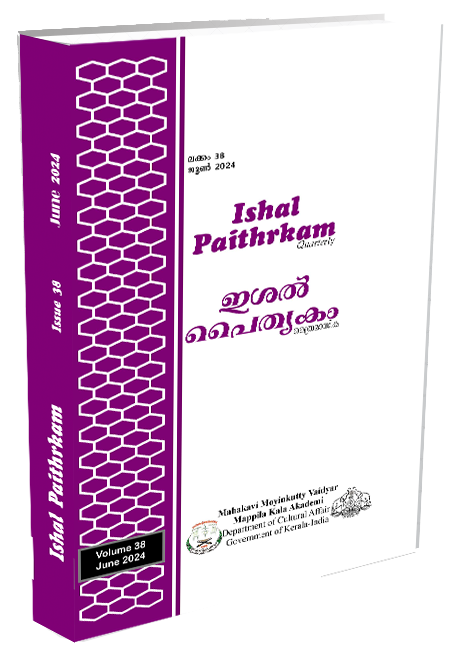Cultural Identity Transaction in Bharati Mukherjee’s Novels: A Study of Jasmine and Leave it to Me
Keywords:
Cultural identity transaction, multicultural society, assimilation, self-discovery, cultural differencesAbstract
This study seeks to explore the theme of cultural identity transactions in Bharati Mukherjee’s novels, specifically Jasmine and Leave It to Me. The novels depict the experiences of immigrants and their struggles with assimilation and self-discovery in a multicultural society. The study examines the protagonist’s journeys, challenges, and societal expectations as they navigate their cultural identities. Mukherjee’s works highlight the complexities of postcolonialism and the impact of globalization on cultural identity. The study utilizes a qualitative exploratory method to understand the exploration of identity, lifestyle, experiences, and challenges in Mukherjee’s novels. Moreover, the novels emphasize the importance of cultural exchange and understanding in promoting empathy and inclusivity in a diverse world.
Downloads
References
ArtReview. (2014). Stuart Hall, 1932–2014. Artreview.Com.
Ashcroft, B. (2012). Introduction: Spaces of Utopia. Spaces of Utopia: An Electronic Journal, 2(1), 6. http://ler.letras.up.pt
Basu, S. (2019). Oppression and marginalization in the novels of Mahasweta Devi and Bharati Mukherjee. Comparative Literature Studies, 55(1), 89–105.
Bhuvani, D., & Dharageswari, Dr. J. (n.d.). R.K. Narayan and Bharati Mukherjee cultural Transactions in their novels – a comparative study. Ilkogretim Online - Elementary Education Online, 20(4), 1183–1186.
Bingham, N. E. (1972). Toffler, Alvin. Future shock. New York: Bantam Books, Inc., 1971 (540 pages). Science Education, 56(3). https://doi.org/10.1002/sce.3730560328
Chakraborty, A. (2015). Cultural identity and resistance in the novels of Mahasweta Devi. Indian Literature, 59(3), 124–137.
Epstein, M. (1999). From Culturology to Transculture. In Transcultural Experiments: Russian and American Models of Creative Communication. New York: St. Martin’s Press (pp. 15–30). St. Martin’s Press.
Goswami, Dr. A. (2018). Unhousement To Rehousement: A Cultural Encounter, Ethnicity To Identity In The Novels of Bharati Mukherjee. 4(7).
Gupta, S. (2017). Negotiating identity: A study of Mahasweta Devi’s protagonists. Journal of Indian Writing in English, 45(2), 56–68.
Hall, S. (1990). Cultural Interaction and Diaspora. In J. Rutherford (Ed.), Identity, Community, Culture and Difference. Lawrence and Wilsart Ltd.
Heidegger, M. (1971). Building, Dwelling, Thinking Poetry, Language, Thought (Trans. Alfred Hofstadter, Ed.). Harper and Row.
Hornby, A. S. (1974). Oxford Advanced Learners’ Dictionary of Current English. Oxford University Press.
Inamdar, F. A. (1993). Man-Woman Relationship in The Tiger’s Daughter and Wife. In K. N. Awasthi (Ed.), Contemporary Indian English Fiction. ABS Publication.
Iyengar, K. R. S. (1973). Indian Writing in English. Asia Publishing House.
Kapoor, M. (1996). The immigrant experience in Bharati Mukherjee’s fiction. Journal of Postcolonial Studies, 22(4), 567–582.
Kumar, N. (2001). The Fiction of Bharati Mukherjee A Cultural Perspective. Atlantic Publishers and Distributors.
Morrison, T. (2003). The Source of Self-Regard: Selected Essays, Speeches, and Meditations. Alfred A. Knopf.
Mukherjee, B. (1991). Jasmine. New York/ : Fawcett Crest.
Mukherjee, B. (1997). Leave it to me. New York/ : A. A. Knopf.
Pandey, A. (2023). Culture and Society. Anthroholic.com.
Parvez, S., & Siddiqui, Dr. Z. (2023). Exploring the Identity Crisis in Mahasweta Devi’s Novel The Glory of Sri Sri Ganesh. Ishal Paithrkam, 33, 83.
Parvez, S., & Siddiqui, Dr. Z. (2024). Transcending The Cultural Boundaries And Finding Feet: Representation Of Culture Shock U- Curve In The Novels Of Bharati Mukherjee. Educational Administration: Theory and Practice, 30(4), 4263–4269.
Procter, J. (2004). Stuart Hall. Routledge.
Rajak, Dr. R., & Singh, Dr. A. (n.d.). Social Environment in the Literary World of Mahasweta Devi. Knowledge Resonance, 150–153.
R.K. Narayan and Bharati Mukherjee cultural Transactions in their novels – a comparative study. (n.d.). Ilkogretim Online - Elementary Education Online, 20(4), 1183–1186. https://doi.org/10.17051/ilkonline.2021.04.133
Roy, R. (2016). Cultural adaptation and diasporic identities in Bharati Mukherjee’s novels. South Asian Review, 37(1), 34–48.
Shahi, A. (2016). Jasmine’s Sense of Fulfilment A Re-Reading of Bharti Mukharjee’s Jasmine in the context of Woman Empowerment in India. 5(2).
Skulj, J. (2000b). Comparative Literature and Cultural Identity. CLCWeb: Comparative Literature and Culture, 2(4). https://doi.org/10.7771/1481-4374.1088
Srivastava, Dr. M., & Srivastava, Dr. R. (2019). Migrant Writings: Identity And Cultural Crisis In Bharati Mukherjee’s “Desirable Daughters” And Jasmine. Langlit, 6(1), 10–14. Www.Langlit.Org
Steiner, G. (1968). Extraterritorial. Penguin Books: Harmonsworth.
Tikoo, S. K. (1991). The American Dream: Immigration and Transformation Theme in The Middleman and other Stories. In R. K. Dhawan (Ed.), Indian Women Novelists (1st ed., Vol. 5). Prestige Books.
Transnational Feminism – Sociology of Genders. (n.d.). Ebooks.inflibnet.ac.in. Retrieved June 23, 2024, from https://ebooks.inflibnet.ac.in/socp10/chapter/transnational-feminism/
Williams, P., & Chrisman, L. (Eds.). (1994). Cultural Identity and Diaspora. In Colonial Discourse and Post-colonial Theory: A Reader. Harvester Wheat Sheaf.
Additional Files
Published
Issue
Section
License
Copyright (c) 2025 ISHAL PAITHRKAM

This work is licensed under a Creative Commons Attribution-NoDerivatives 4.0 International License.

